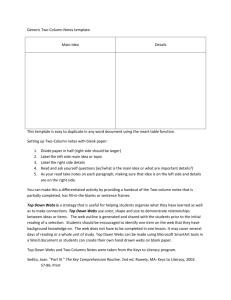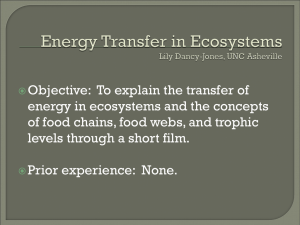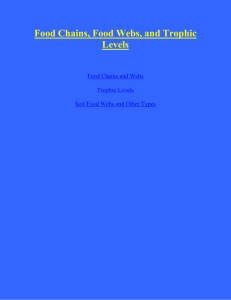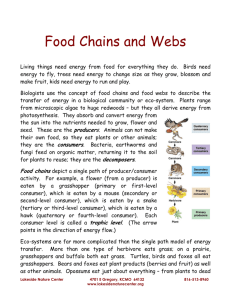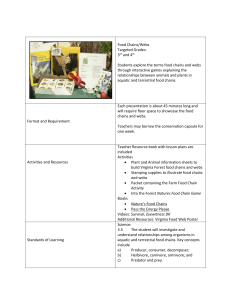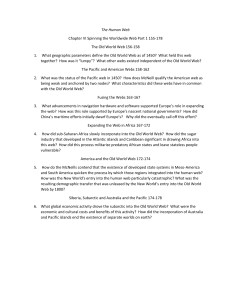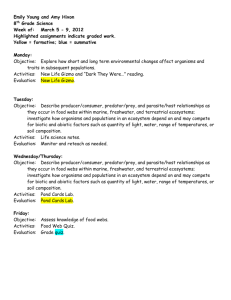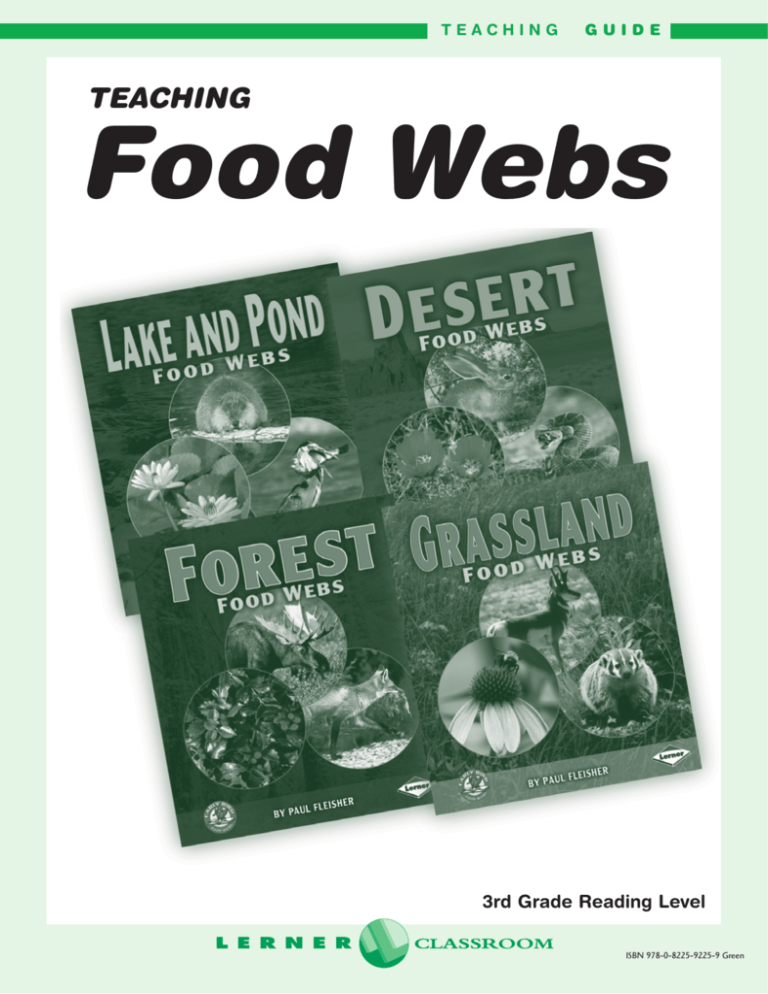
TEACHING
GUIDE
TEACHING
Food Webs
3rd Grade Reading Level
ISBN 978-0-8225-9225-9 Green
2
TEACHING
FOOD WEBS
Standards
Science
• Understands relationships among organisms and their physical environment.
• Understands biological evolution and the diversity of life.
• Understands the nature of scientific inquiry.
Language Arts
• Gathers and uses information for research purposes.
• Uses the general skills and strategies of the reading process.
• Uses reading skills and strategies to understand and interpret a variety of
informational texts.
• Uses listening and speaking strategies for different purposes.
Visual Arts
• Understands the characteristics and merits of one’s own artwork and the artwork of
others.
Working with
Others
• Contributes to the overall effort of a group.
• Displays effective interpersonal communication skills.
Multiple Intelligences Utilized
• Bodily kinesthetic, spatial, linguistic, interpersonal, naturalistic, and intrapersonal
Copyright © 2008 by Lerner Publishing Group, Inc.
All rights reserved. International copyright secured. Student pages may be
reproduced by the classroom teacher for classroom use only, not for commercial
resale. No other part of this teaching guide may be reproduced, stored in a
retrieval system, or transmitted in any form or by any means—electronic,
mechanical, photocopying, recording, or otherwise—without the prior written
permission of Lerner Publishing Group, Inc., except for the inclusion of brief
quotations in an acknowledged review.
LernerClassroom
A division of Lerner Publishing Group, Inc.
241 First Avenue North
Minneapolis, MN 55401 U.S.A.
800-328-4929
Website address: www.lernerclassroom.com
Manufactured in the United States of America
1 2 3 4 5 6 — IG — 13 12 11 10 09 08
Books in the Food Webs series
include:
Desert Food Webs
Forest Food Webs
Grassland Food Webs
Lake and Pond Food Webs
Ocean Food Webs
Tundra Food Webs
TEACHING
Lesson 1
Who Am I?
Purpose: Students will identify the various roles
animals and plants fulfill in an ecosystem.
Materials
• Food Webs books
• Who Am I? p. 10
• overhead of Who
Am I? p. 10
• large index cards
(2 per student)
• colored pencils or
markers
• chart paper or
chalkboard
• markers or chalk
• pencils
• butcher paper
• tape or stapler
Objectives
• Define herbivore, omnivore, and carnivore.
• Classify animals by the roles they play in an ecosystem.
• Determine which animals live in a particular ecosystem.
• Identify animals based on clues during a game.
• Create cards depicting and describing a specific animal.
Activity Procedures
Prepare
(teacher)
• Read the Food Webs books.
• Make an overhead of Who Am I? p. 10.
• Cover a bulletin board with butcher paper.
• Label the bulletin board, “Who Are We?”
Pretest
(teacher, students)
• On a piece of chart paper, make a KWL chart.
• Ask students what they know about what animals and
plants eat.
• Write responses under the K column of the KWL
chart.
• Ask students what they want to find out about what
animals and plants eat.
• Write responses under the W column of the KWL
chart.
• Tell students that they will write what they learned
under the L column during a different lesson.
FOOD WEBS
Read
(small groups)
• Each small group will read one book from the Food
Webs series.
Model
(teacher, students)
• Put up the overhead of Who Am I? p. 10.
• Ask students if any of the animals at the top of the
page look familiar.
• Review the terms herbivore, omnivore, and carnivore.
• Model asking and answering a Who Am I? question
from the overhead.
• As a class, answer the rest of the Who Am I? questions
from the overhead.
• Tell students they are going to use index cards to
make their own Who Am I? questions about an
animal they read about.
Practice
(students)
• Draw a picture of an animal on one index card.
• On another index card, write a series of clues about
the animal’s identity. At the bottom of the card,
write Who Am I?
• Post the index card with the animal picture on the
bulletin board under the “Who Are We?” label.
• Turn the clue card in to the teacher.
Discuss
(teacher, students)
• Tell students that over the next couple of weeks,
their clue cards will be read aloud.
• The class will have to guess the identity of the animal
by listening to the clues and looking at the Who Are
We? bulletin board.
Evaluate
(teacher)
• Read each of the clue cards turned in by the students
and assess for understanding.
• While playing “Who Am I?” note which students are
struggling with learning vocabulary.
3
4
TEACHING
FOOD WEBS
Lesson 2
Food Web—Part 1
Purpose: Students will study the organisms in their
community and will create a paper food chain illustrating
the relationships that exist between the organisms.
Materials
• Food Webs books
• paper strips (green,
red, purple, yellow)
• tape or stapler
• markers
• In My Community
p. 11
• overhead of In My
Community p. 11
• books about animals
and plants in the
community
• chart paper or chalk
board
Objectives
• Review the name of the environment in which
students live.
• Discuss the organisms that live in that environment.
• Investigate the relationships between the producers,
consumers, and decomposers in the community.
• Diagram a food chain that exists in the community.
• Create a food chain using paper strips.
• Summarize how the organisms fit into the food chain.
Activity Procedures
Prepare
(teacher)
• Divide students into groups of about five.
• Cut several green, red, and purple paper strips for
each group.
• Cut several yellow strips and set aside.
• Make a copy of In My Community p. 11 for each
group.
• Make an overhead of In My Community p. 11.
• Make a chart listing these words: Ocean, Lake and
Pond, Grassland, Desert, Forest, and Tundra.
Pretest
(teacher, students)
• Ask students which word on the chart best describes
the environment in which they live.
• Review aspects of that environment, such as plant
and animal species, amount of rainfall, and climate.
Read
(small groups)
• Review the Food Webs book that describes the
environment in which the students live.
• Skim other books about the organisms that live in
the students’ community.
Model
(teacher)
• Put up an overhead of In My Community p. 11 and
demonstrate how to research and take notes on the
plants and animals in the community.
• To make a food chain, write the name of a producer
on a green strip, a consumer on a red strip, and a
decomposer on a purple strip. Roll each strip into a
circle and tape or staple it together, hooking it onto
another loop.
• Show students the finished paper food chain.
• Explain that each group will make a food chain using
the plants and animals from their list.
Practice
(small groups)
• Research the producers, consumers, and decomposers
in your community, and list them on In My
Community p. 11.
• Write what the organisms on the list eat/are eaten by.
• Identify organisms that create a food chain.
• Create a paper food chain by rolling the strips into
circles and linking them together.
Discuss
(teacher, class)
• What did you find out about the plants and animals
in our community?
• Where do we fit in the food chain?
Evaluate
(teacher)
• Collect In My Community p. 11 from each group
and assess for accuracy, comprehension, and neatness.
TEACHING
Lesson 3
Food Web—Part 2
Purpose: Students will learn how multiple food
chains create a food web.
Materials
• Food Webs books
• food chains made in
Lesson 2
• tape or stapler
• yellow paper strips
• paper strips of other
colors
• KWL chart from
Lesson 1
Objectives
• Describe the terms food chain and food web.
• Discuss the complexities of a food web.
• Determine connections between food chains.
• Identify why connections are made between food
chains.
• Create a model food web.
• Summarize concepts learned on the KWL chart.
Activity Procedures
Prepare
(teacher)
• Cut some extra paper strips to connect food chains.
Pretest
(teacher, students)
• What is the difference between a food chain and a
food web?
• Which do you think more accurately shows what is
happening in an ecosystem?
Read
(small groups)
• Each group will read a Food Webs book not
previously read.
FOOD WEBS
Model
(teacher, students)
• Ask students to sit in a circle in the center of the
room, with their food chains from Lesson 2.
• Explain that food webs are more complex than food
chains, and many food chains make up a food web.
• Tell students that they will be creating a food web as
a class by combining their food chains.
• Model connecting two food chains by explaining
that something in one chain can eat something in
another chain. (E.g. “This chain has a mouse, and this
chain has a snake. Can a snake eat a mouse? Yes. We
can link these chains together.”)
Practice
(students)
• Find connections between the food chains.
• Use paper strips to link the food chains together.
• Use yellow strips (representing the sun) to connect
all of the producers together.
Discuss
(teacher, students)
• Did you find many connections?
• Where would human beings fit into this food web?
• Which plants or animals seem to have the most
connections? Why do they have so many
connections?
• What would happen if those plants or animals died
out?
Evaluate
(teacher, students)
• Using the KWL chart from Lesson 1, ask students to
fill in things they have learned about food chains and
webs in the L column.
• Evaluate students’ comprehension of food webs using
the KWL chart.
5
6
TEACHING
FOOD WEBS
Lesson 4
Energy and the
Environment
Purpose: Students will learn about how energy is
transferred in an ecosystem.
Materials
• Food Webs books
• Grasslands Energy
Pyramid p. 12
• chalkboard or chart
paper
• chalk or markers
• scissors
• glue
Objectives
• Define energy.
• Explain how plants and animals get energy.
• Demonstrate knowledge of how energy is transferred
in a food web.
• Determine how energy affects the number of
organisms on each level of the pyramid.
• Place producers, consumers, and decomposers on the
appropriate levels of an energy pyramid.
• Justify choices made while completing Grasslands
Energy Pyramid p. 12.
Activity Procedures
Prepare
(teacher)
• Copy Grasslands Energy Pyramid p. 12 for each
student.
Pretest
(teacher, students)
• What is energy?
• Where does energy come from?
• How do you use energy?
Read
(small groups)
• Each small group will read a Food Webs book not
previously read.
Model
(teacher)
• Draw a pyramid on a chalkboard or piece of chart
paper.
• Divide the pyramid into four horizontal parts, and
label the parts (from bottom to top): producers, 1st
level consumers, 2nd level consumers, and 3rd level
consumers. Label the area below the pyramid
decomposers.
• Tell students that scientists often draw pyramids like
this one to explain how energy moves in a food web.
• Explain that energy is lost at each level of the
pyramid. The producers use energy to create their
own food. Consumers use it to move around, keep
warm, and have babies.
• Ask students to think about where a tree, a squirrel, a
snake, and a fox would fit on the pyramid. Label
each level accordingly.
• Describe the relationship between the number of
organisms on each level and the amount of energy it
takes for those organisms to survive.
Practice
(students)
• Cut out the boxes from the bottom of Grasslands
Energy Pyramid p. 12.
• Glue the producers, consumers, and decomposers on
the correct levels of the pyramid.
Discuss
(teacher, class)
• Why are there more organisms at the bottom of the
pyramid?
• Why are there so few third level consumers?
• Who has the most energy in the food chain? Why?
Evaluate
(teacher)
• Collect Grasslands Energy Pyramid p. 12 from each
student and assess for comprehension.
TEACHING
Lesson 5
Food Web Games
Purpose: Students will create cards for food web
games and will learn how to play the games.
Materials
• Food Webs books
• index cards
• colored pencils
• pencils
• Corner Directions
p. 13
• Match Directions
p. 14
Objectives
• Recall the meanings of the terms producer, consumer,
and decomposer.
• Distinguish between organisms that live in different
environments.
• Illustrate and write about producers, consumers, and
decomposers from specific environments.
• Analyze the adaptations that help organisms live in
their environments.
Activity Procedures
Prepare
(teacher)
• Divide students into groups of three.
• Give each group 18 index cards and 6 different
colored pencils.
• Copy Corner Directions p. 13 and Match Directions
p. 14 for each group.
Pretest
(teacher, students)
• What is a producer? A consumer? A decomposer?
• What is an adaptation?
• How do animals use adaptations to survive in their
environments?
Read
(small groups)
• Each group will read a Food Webs book not
previously read.
FOOD WEBS
Model
(teacher)
• Tell students that they are going to create playing
cards.
• Show students the cover of Forest Food Webs.
• Write “Forest” at the top of three index cards in
green pencil.
• Write the name of a forest producer on one card, the
name of a forest consumer on another card, and the
name of a forest decomposer on the last card.
• Draw a picture of each organism under its name and
talk about how it has adapted to survive in its
environment.
• Do the same with the other cards, using information
from a different Food Webs book.
Practice
(groups of three)
• Each student will use two different Food Webs books
and six index cards.
• The group will assign different colored pencils to
each Food Webs book. Students will use the assigned
colored pencils to write on the index cards (e.g.
Ocean could be blue).
• Students fill out three index cards for each book, one
about a producer, one about a consumer, and one
about a decomposer.
• Each card will be clearly labeled with the name of
the environment and the name of the producer,
consumer, or decomposer from that environment.
• Students will draw pictures of the organisms on the
cards.
• Students will discuss how the organisms on the cards
have adapted to their environment.
Discuss
(teacher, students)
• Tell students to shuffles their cards.
• Read the game directions on Corner Directions p. 13
and Match Directions p. 14.
• Discuss questions about the games.
• Demonstrate how to play the games.
• Play the games!
Evaluate
(teacher)
• As students are playing the games, walk around and
note which students are struggling with food web
concepts.
7
8
TEACHING
FOOD WEBS
Lesson 6
Tundra Tag
Purpose: Students will learn that food webs are
constantly fluctuating.
Materials
• Food Webs books
• green paper strips
• brown, red, and
yellow construction
paper
• string
• hole punch
• brown paper lunch
bags
• Tundra Tag Directions
p. 15
• Food Web
Assessment p. 16
Objectives
• Review a specific food chain from the tundra.
• Classify organisms based on their roles in a food
chain.
• Explore how energy is transferred while playing
Tundra Tag.
• Analyze what happens to ecosystems in different
scenarios.
• Model different scenarios while playing Tundra Tag.
• Summarize knowledge of food webs.
Activity Procedures
Prepare
(teacher)
• Cut 70 strips of green paper and set aside. (This is the
lichen.)
• Cut the other colors of construction paper into
name-tag-sized pieces. There should be 15-17 yellow
pieces (lemmings), 5-7 red pieces (foxes), and 2-3
brown pieces (bears). There should be a piece for
everyone in the classroom.
• Punch holes in the top two corners of the colored
pieces of paper and tie strings through both holes so
students can wear necklace-style identification tags.
• Arrange to use the gym or an open playing field for
the game.
Pretest
(teacher, students)
• What happens to the plants and animals in an
ecosystem if there is a fire?
• What happens if one population gets too large? Too
small?
Read
(small groups)
• Each group will read a Food Webs book not
previously read.
Model
(teacher)
• Using the diagram on p. 4 in Tundra Food Webs,
describe the food chain containing lichen, lemmings,
foxes, and bears.
• Tell students that they will be playing a game to show
what happens in an ecosystem.
• Explain that the green paper strips represent lichen,
the yellow tags represent lemmings, the red tags
represent foxes, and the brown tags represent bears.
• Tell students that each of them will have a role to
play in the game.
• Read Tundra Tag Directions p. 15 to the students.
Practice
(students)
• Play Tundra Tag!
Discuss
(teacher, students)
• Talk about the scenarios listed on Tundra Tag
Directions p. 15.
• Discuss the complexity of food webs and ecosystems.
• Discuss how people fit into the food web and the
impact they can have on it.
Evaluate
(students, teacher)
• Students complete Food Web Assessment p. 16.
• The teacher will collect and grade each student’s
Food Web Assessment p. 16.
TEACHING
Additional Resources
BOOKS
Crenson, Victoria. Horseshoe Crabs and Shorebirds: The
Story of a Food Web. New York: Marshall
Cavendish Corporation, 2003.
This picture book tells the story of a food web in
Delaware Bay.
Johnson, Rebecca L. A Walk in the Deciduous Forest.
Minneapolis: Carolrhoda, 2001.
The Biomes of North America series helps
students learn about the plants, animals, and
climates of various biomes.
Kalman, Bobbie. Food Chains and You. New York:
Crabtree Publishing Company, 2004.
How do humans fit into the food chain? Find
out with this straightforward book.
Lauber, Patricia. Who Eats What? Food Chains and
Food Webs. New York: Harper Collins, 1995.
Learn about the basic ideas behind food chains
and webs.
Markle, Sandra. Crocodiles. Minneapolis: Lerner
Publishing Group, 2004.
Books in the Animal Predators, Animal
Scavengers, and Animal Prey series teach students
about roles animals fulfill in their environments.
Relf, Pat. The Magic School Bus Gets Eaten: A Book
about Food Chains. New York: Scholastic
Paperbacks, 1996.
Ms. Frizzle and her class go on a magical field trip
into a food chain to learn first-hand how it
works.
Schwartz, David. Look Once, Look Again: At the Pond.
Milwaukee, WI: Gareth Stevens, 1999.
Take a close look at creatures from different
habitats with the Look Once, Look Again! series.
Walker, Sally. Sea Horses. Minneapolis: Lerner
Publishing Group, 2004.
Books in the Early Bird Nature series are helpful
for students researching and writing reports on
animals.
FOOD WEBS
WEBSITES
EcoKids: Chain Reaction
http://www.ecokids.ca/pub/eco_info/topics/
frogs/chain_reaction/index.cfm
The game “Chain Reaction” allows students to
place plants and animals in the correct order in a
food chain. They can also discover what happens
when one animal in the food chain is taken out.
Gould League: Food Webs
http://www.gould.edu.au/foodwebs/kids_web
.htm
Students can learn about food webs in specific
biomes by playing games and creating food webs
on this fun and accessible site.
MBG Net: What’s It Like Where You Live?
http://www.mbgnet.net/
Learn about various biomes around the world
with this kid-friendly website created by the
Missouri Botanical Garden.
National Geographic/Quick Flicks—Food Chains
http://magma.nationalgeographic.com/
ngexplorer/0309/quickflicks/
Watch a cartoon movie about food chains and
webs. This short, informative movie will help
students review basic food web concepts and
vocabulary.
Scholastic: Endangered Ecosystems
http://teacher.scholastic.com/activities/explorer/
ecosystems/be_an_explorer/map/form.htm#
Students will use their knowledge of producers,
consumers, and decomposers to create a food
web of a Mexican ecosystem.
9
10
Who Am I?
Name
Javelina
Bull Snake
White-Tailed
Grizzly Bear Snapping Turtle
Deer
Kelp Crab
1. I live in the ocean. I eat plants. I can turn bright red. Who am I?
_________________________________________
2. I live in the tundra. I am an omnivore. I like berries. Who am I?
_________________________________________
3. I am an herbivore. I live in the forest. Who am I?
_________________________________________
4. I am a carnivore. I live in the grasslands. I squeeze my prey to death. Who am I?
_________________________________________
5. I am an omnivore from the desert. I enjoy eating the prickly pear cactus. Who am I?
_________________________________________
6. I have a hard shell and a quick bite. I am an omnivore from a lake or pond. Who am I?
_________________________________________
Teaching Food Webs
11
qytfqytfqytfqytfqytfq
y
y
In My Community
t
t
Name
f
f
q Producer in my community
q
Is eaten by
y
y
t
t
f
f
q
q
y
y
t
t
f
f
q
q
y
y
Consumer in my community
Eats
Is eaten by
t
t
f
f
q
q
y
y
t
t
f
f
q
q
y
y
t
t
f
f
Decomposer in my community
Eats
Is eaten by
q
q
y
y
t
t
f
f
q
q
y
y
t
t
f
f
qytfqytfqytfqytfqytfq
Teaching Food Webs
12
Grasslands Energy Pyramid
Name
3rd Level Consumers
2nd Level Consumers
1st Level Consumers
Producers
Decomposers
Teaching Food Webs
13
hjhjhjhjhjhjhjhjhjhjhj
h
h
Corner Directions
j
j
(Part of Lesson 5)
h
h
j
j Players: 3
h Materials: 18 cards made in Lesson 5, three extra cards for extension activity (see h
j
j Extension below)
h
h Goal: To “corner” the market by getting all of the producer cards, all of the
j
j consumer cards, or all of the decomposer cards.
h
h 1. Shuffle the cards.
j
j
h
h 2. Deal the cards to the three players.
j 3. Look at the cards you have been dealt. Decide which type of card you want to j
h
h “corner” (producers, consumers, or decomposers).
j
j 4. The teacher says “Begin trading!”
h
h
5. Everyone trades at once. There is no waiting in this game. Do not show your
j
j cards to people while you are trading.
h
h
6. If you have one card you want to trade, say “One! One! One!” until someone
j
j trades with you. If you have two cards you want to trade, they need to be the
h
h same kind (e.g. two producer cards). You shout out “Two! Two! Two!” until
j
j someone trades two cards with you.
h
h 7. Once you have all six of the producer cards, consumer cards, or decomposer
j
j cards you need to shout, “Corner!”
h 8. The first person to collect six of a kind and shout “Corner!” earns 100 points. h
j
j
9. The first person in the group to get 300 points wins.
h
h
j
j Extension: The group can create a Disease card, a Storm Card, and a Wildlife
Refuge Card to add to the game. If a player has these cards at the end of a game,
h
h
they can either add points to or subtract points from their score.
j
j Wildlife Refuge Card – add 50 points to your score
h
h Disease Card – subtract 20 points from your score
j
j Storm Card – subtract 50 points from your score
hjhjhjhjhjhjhjhjhjhjhj
Teaching Food Webs
14
Match Directions
(Part of Lesson 5)
Players: 3
Materials: 18 cards made in Lesson 5
Goal: To have the most cards at the end of the game.
1. Shuffle the cards.
2. Lay the cards face down in three rows.
3. Turn over any three cards. If you have made a match, you can keep the cards. A match is
made when all three cards are the same color and are from the same environment.
4. If you have made a match, you get another turn. If not, turn the cards face down and let
the next player have a turn.
5. You will need to remember where the cards are located when other players turn them
over. If you remember, you can make a match when your turn comes.
6. The player with the most cards at the end of the game wins.
Teaching Food Webs
15
Tundra Tag Directions
(Part of Lesson 6)
Players: 20-30 students
Materials: identification necklaces (lemming, fox, and bear),
brown bags (stomachs), green paper strips (lichens)
Goal: To discover what happens to a food web under various
circumstances.
1. Spread fifty green strips (lichens) around the playing area.
2. Hand out identification tags and brown bags to all of the
students.
3. (30 sec) All lemmings enter the game. They try to get as many lichens in their
stomachs as possible.
4. (1 min) All foxes enter the game. They try to tag the lemmings. If they tag a lemming, the
lemming has to give the fox all of their lichens. The fox puts the lichens in its own stomach.
The tagged lemming has to stand near the teacher.
5. (2-3 min) All bears enter the game. They try to tag the foxes. If they tag a fox, the fox has
to give the bear all of their lichens. The bear puts the lichens in its own stomach. The tagged
fox has to stand near the teacher.
6. The teacher calls out “Freeze!” and has the players check their stomachs. Those without
food in their stomach have to stand near the teacher. As a class, discuss which animals
survived and which animals died.
Play the game again, using one of the following scenarios:
• There has been a fire on the tundra. Lichens burn quickly and grow back slowly. Play the
game with half the number of lichens. Discuss the result of the fire after the game.
• A disease has spread through the lemming population. Many of them died. Play the game
with half the number of lemmings. Discuss the effect of disease on a food web.
• A wildlife restoration project was started in the tundra. People were not allowed to walk or
drive over the tundra surface. Lichens and other plants slowly grow back. Add 20 lichens to
the game and play. Discuss how this impacts the food web.
Teaching Food Webs
16
Food Web Assessment
Name
1. What is a producer? Give an example of a producer.
2. What is a consumer? Explain the three different kinds of consumers.
3. What is a decomposer? What would happen in an environment if there were no
decomposers?
4. Put the following living things in order in a food chain: turkey vulture, prickly pear cactus,
sidewinder rattlesnake, and pack rat.
5. How do plants get energy? How do animals get energy?
6. Look at the food web below. What would happen if all of the kelp crabs in this
environment died from disease?
Teaching Food Webs
red sea
urchin
sea
otter
killer
whale
giant
kelp
kelp
crab
giant
octopus



